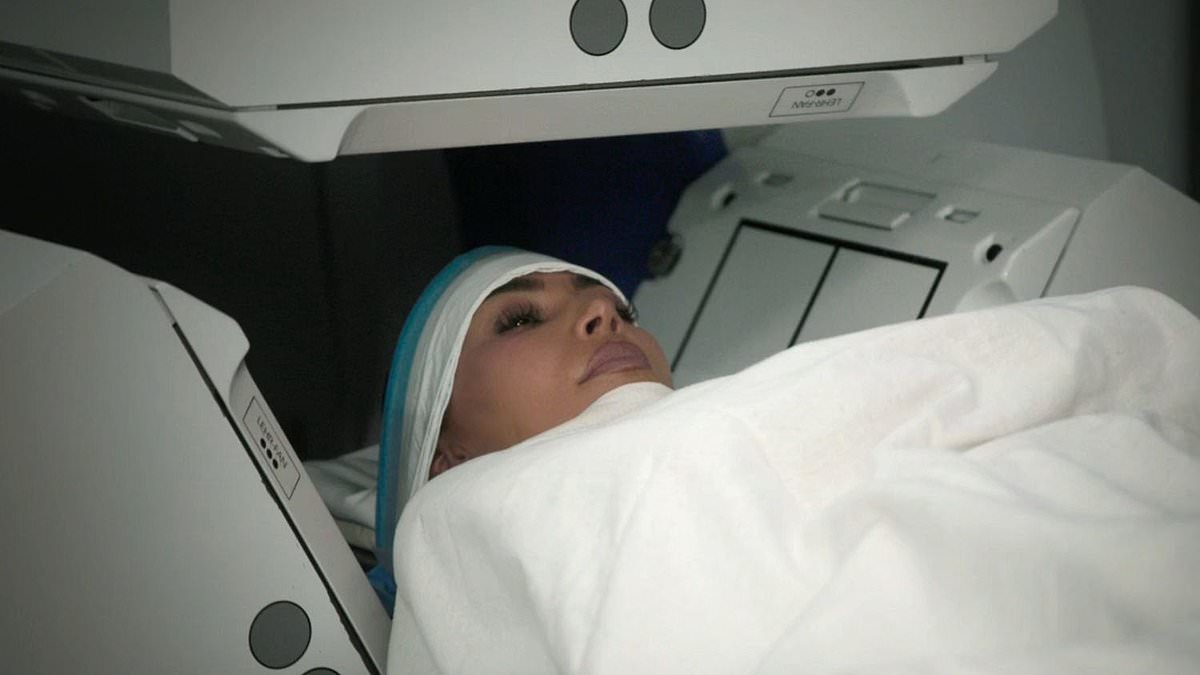Technology
Subtle Indicators of a Brain Aneurysm: Insights Following Kim Kardashian’s Recent Diagnosis
Kim Kardashian recently alarmed her followers by disclosing her diagnosis of a brain aneurysm.
The 45-year-old reality star, a mother to four, shared this health update on Thursday, which emerged in the teaser for the upcoming seventh season of her family’s series on Disney+, “The Kardashians.”
A brain aneurysm is characterized by a bulge in a blood vessel within the brain.
These aneurysms are fairly prevalent, as about 3% of the UK population—approximately two million people—live with one that hasn’t ruptured.
Typically, most brain aneurysms are small and asymptomatic, often going unnoticed unless discovered through a brain scan for unrelated issues.
Nevertheless, larger aneurysms can manifest through symptoms such as headaches, pain near the eyes, visual disturbances, dizziness, balance issues, facial numbness or weakness, and problems with concentration and memory.
If you experience any of the above it is crucial to seek advice from your GP who can refer you to specialists for further tests and investigations.
Aneurysms are diagnosed in hospitals using specialised imaging tests which allow doctors to get detailed images of the brain and blood vessels.
These include CT, MRI or MRA scans—which Kim is having in The Kardashians trailer—and lastly a cerebral angiography.
This is when dye is injected into the arteries to provide clear, detailed pictures of the blood vessels in the brain and highlight any aneurysm.
In the clip, Kim implies that her aneurysm is the result of her stressful split from her ex-husband, rapper Kanye West, but doctors say there is very little evidence to suggest that stress alone can directly cause an aneurysm.
However, stress can lead to high blood pressure, which raises the risk of developing one.
Whilst most aneurysms remain stable, around one in every 100 will rupture—often without warning—causing a brain bleed known as a subarachnoid haemorrhage, a rare but life-threatening type of stroke.
The main symptom is a sudden, severe headache that’s sometimes described as a ‘thunderclap headache’.
The haemorrhage can happen at any time, but it may be more likely when a patient puts strain on their body—either by coughing, lifting something heavy or engaging in sexual intercourse.
Each year, an estimated 3,000 to 5,000 people in the UK will suffer a ruptured aneurysm, with around half of these cases proving fatal.
But, not everyone who has a brain aneurysm will need treatment, according to the NHS.
This is because they often do not increase in size, and have a relatively low risk of bursting, especially if they’re not causing symptoms.
Low-risk aneurysms will be monitored by doctors for growth or abnormalities.
Doctors will consider the location, size, shape and a patient’s family history to determine whether they need treatment.
If there’s a considerable risk of the aneurysm bursting, or if it has already ruptured, there are two main types of surgery doctors will likely consider: surgical clipping and endovascular surgery.
Surgical clipping involves attaching a small metal clip to the affected blood vessel in the brain, to restrict blood flow to the aneurysm, whereas endovascular surgery involves inserting a small piece of wire mesh directly into the aneurysm to slow the flow of blood and encourage a blood clot to form.
Whilst it is not always clear what causes brain aneurysms, there are a number of factors that can increase your chance of developing the swelling.
These include smoking, high blood pressure, having a close relative who has had a brain aneurysm, trauma to the brain which damages a blood vessel, taking drugs like cocaine and having certain genetic conditions like Ehlers-Danlos Syndrome—a group of inherited conditions that affect connective tissue.
Details about Kim’s current condition remain unclear, with no indication as to whether she is experiencing any symptoms.
But she has been open about her previously health battles, having long suffered with two autoimmune conditions.
In 2022, she revealed that her 16 pound weight loss in order to fit into Marilyn Monroe’s iconic gown at the Met Gala that year caused her body to have a psoriasis flare up that led to psoriatic arthritis.
And in 2015, she spoke about suffering from placenta accreta, which occurs when the placenta—the organ that provides the fetus with nutrients—attaches too deeply to the uterine wall, increasing the risk of heavy bleeding after birth.
Kim Kardashian recently alarmed her followers by disclosing her diagnosis of a brain aneurysm.
The 45-year-old reality star, a mother to four, shared this health update on Thursday, which emerged in the teaser for the upcoming seventh season of her family’s series on Disney+, “The Kardashians.”
A brain aneurysm is characterized by a bulge in a blood vessel within the brain.
These aneurysms are fairly prevalent, as about 3% of the UK population—approximately two million people—live with one that hasn’t ruptured.
Typically, most brain aneurysms are small and asymptomatic, often going unnoticed unless discovered through a brain scan for unrelated issues.
Nevertheless, larger aneurysms can manifest through symptoms such as headaches, pain near the eyes, visual disturbances, dizziness, balance issues, facial numbness or weakness, and problems with concentration and memory.
If you experience any of the above it is crucial to seek advice from your GP who can refer you to specialists for further tests and investigations.
Aneurysms are diagnosed in hospitals using specialised imaging tests which allow doctors to get detailed images of the brain and blood vessels.
These include CT, MRI or MRA scans—which Kim is having in The Kardashians trailer—and lastly a cerebral angiography.
This is when dye is injected into the arteries to provide clear, detailed pictures of the blood vessels in the brain and highlight any aneurysm.
In the clip, Kim implies that her aneurysm is the result of her stressful split from her ex-husband, rapper Kanye West, but doctors say there is very little evidence to suggest that stress alone can directly cause an aneurysm.
However, stress can lead to high blood pressure, which raises the risk of developing one.
Whilst most aneurysms remain stable, around one in every 100 will rupture—often without warning—causing a brain bleed known as a subarachnoid haemorrhage, a rare but life-threatening type of stroke.
The main symptom is a sudden, severe headache that’s sometimes described as a ‘thunderclap headache’.
The haemorrhage can happen at any time, but it may be more likely when a patient puts strain on their body—either by coughing, lifting something heavy or engaging in sexual intercourse.
Each year, an estimated 3,000 to 5,000 people in the UK will suffer a ruptured aneurysm, with around half of these cases proving fatal.
But, not everyone who has a brain aneurysm will need treatment, according to the NHS.
This is because they often do not increase in size, and have a relatively low risk of bursting, especially if they’re not causing symptoms.
Low-risk aneurysms will be monitored by doctors for growth or abnormalities.
Doctors will consider the location, size, shape and a patient’s family history to determine whether they need treatment.
If there’s a considerable risk of the aneurysm bursting, or if it has already ruptured, there are two main types of surgery doctors will likely consider: surgical clipping and endovascular surgery.
Surgical clipping involves attaching a small metal clip to the affected blood vessel in the brain, to restrict blood flow to the aneurysm, whereas endovascular surgery involves inserting a small piece of wire mesh directly into the aneurysm to slow the flow of blood and encourage a blood clot to form.
Whilst it is not always clear what causes brain aneurysms, there are a number of factors that can increase your chance of developing the swelling.
These include smoking, high blood pressure, having a close relative who has had a brain aneurysm, trauma to the brain which damages a blood vessel, taking drugs like cocaine and having certain genetic conditions like Ehlers-Danlos Syndrome—a group of inherited conditions that affect connective tissue.
Details about Kim’s current condition remain unclear, with no indication as to whether she is experiencing any symptoms.
But she has been open about her previously health battles, having long suffered with two autoimmune conditions.
In 2022, she revealed that her 16 pound weight loss in order to fit into Marilyn Monroe’s iconic gown at the Met Gala that year caused her body to have a psoriasis flare up that led to psoriatic arthritis.
And in 2015, she spoke about suffering from placenta accreta, which occurs when the placenta—the organ that provides the fetus with nutrients—attaches too deeply to the uterine wall, increasing the risk of heavy bleeding after birth.




